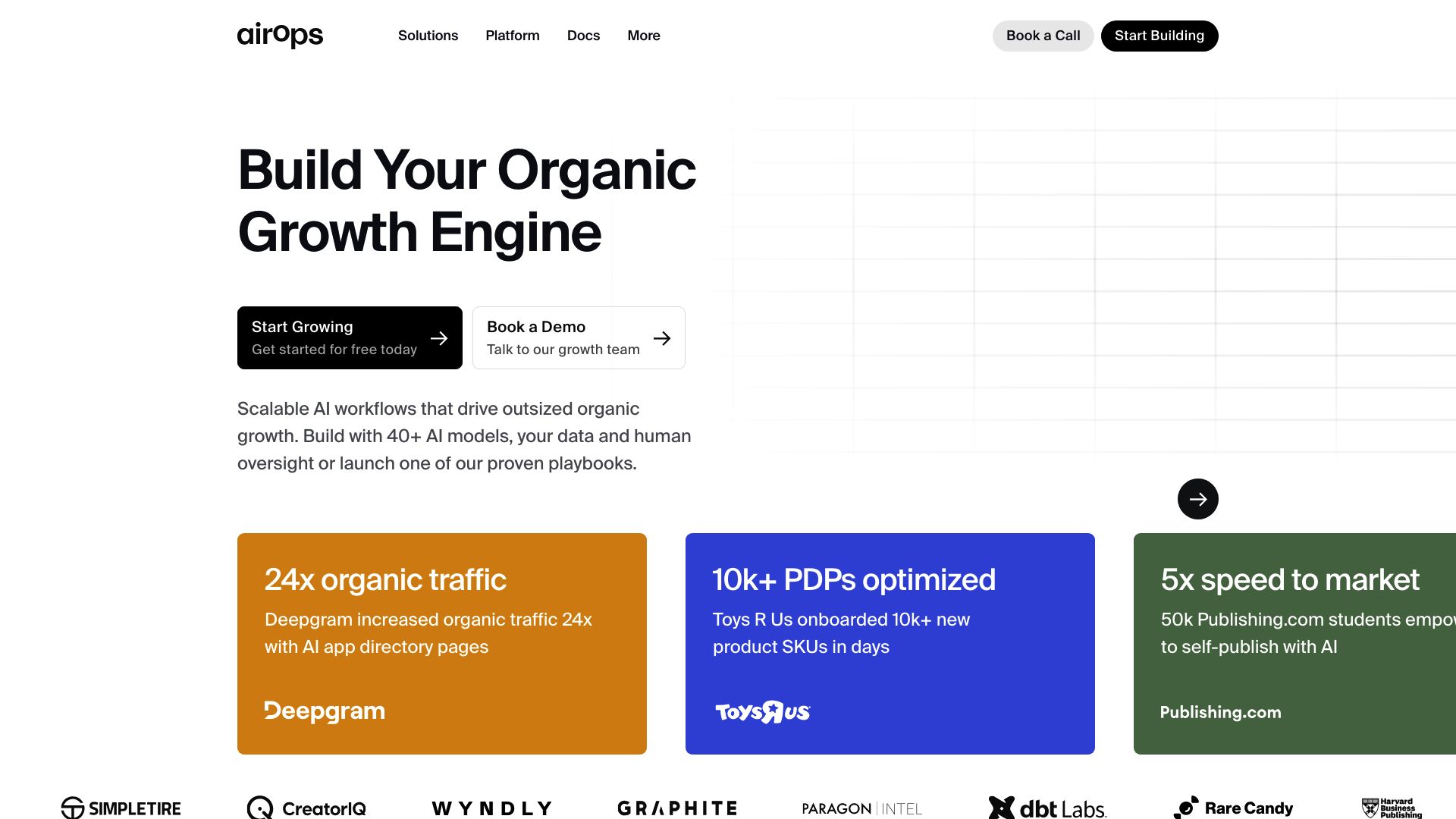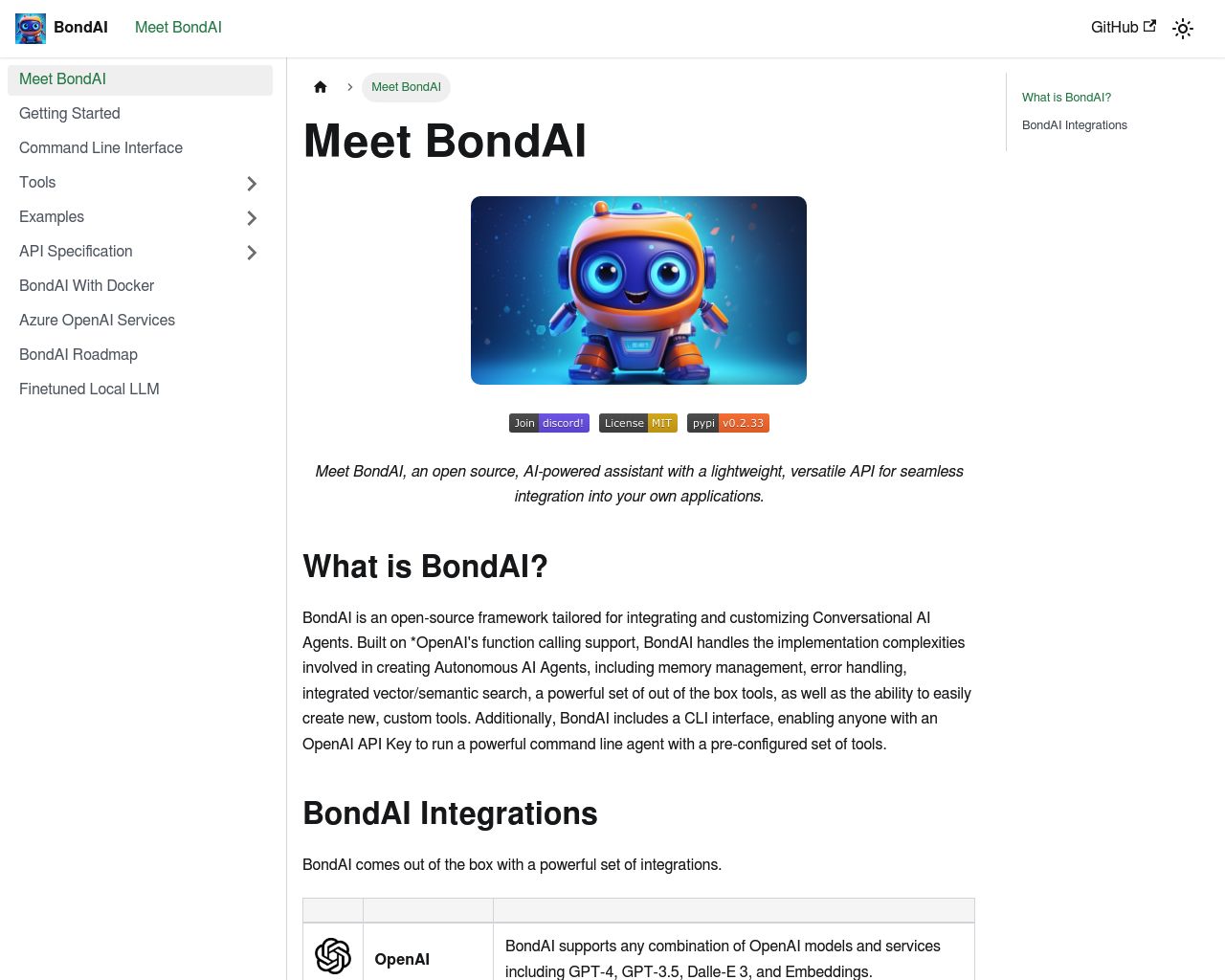AirOps vs. BondAI: Comparing AI Workflow Platforms
AI-powered automation revolutionizes business operations, and choosing the right platform can make or break your digital transformation efforts. This comparison delves into AirOps vs. BondAI, and SmythOS, three leading contenders in the AI agent development space. We’ll explore their unique approaches to workflow creation, agent architecture, and integration capabilities.
Whether you’re a seasoned developer seeking granular control or a business leader looking for intuitive, no-code solutions, this analysis will help you navigate the strengths and limitations of each platform. Discover how these tools tackle critical challenges like scalability, memory management, and deployment flexibility, empowering you to make an informed decision for your AI implementation strategy.
AirOps Overview
AirOps empowers businesses to build scalable AI workflows that drive significant organic growth. The platform enables users to create and implement sophisticated workflows leveraging over 40 AI models, proprietary data, and human oversight. AirOps stands out with its proven playbooks that enhance various business functions, including SEO optimization, product listing management, and content creation.
AirOps excels in providing scalable AI solutions that can handle large volumes of tasks efficiently. This capability proves particularly valuable for companies aiming to optimize processes and reduce manual effort across their operations. The platform’s pre-designed playbooks have demonstrated success in driving tangible results, such as increasing organic traffic and improving product listing quality.
AirOps empowers businesses to build scalable AI workflows that drive significant organic growth… leveraging over 40 AI models, proprietary data, and human oversight.


The flexibility and integration capabilities of AirOps set it apart in the competitive landscape. Users can incorporate various AI models, including text, image, and transcription, alongside data retrieval and human review steps. This versatility allows for highly customizable workflow setups tailored to specific business needs. The platform showcases several success stories where clients have achieved significant boosts in metrics like organic traffic, speed to market, and conversion rates.
Users can incorporate various AI models… alongside data retrieval and human review steps. This versatility allows for highly customizable workflow setups tailored to specific business needs.
AirOps also offers the AI Data Sidekick, a specialized tool designed to assist data practitioners in writing, optimizing, and troubleshooting SQL queries and building Python models more efficiently. This tool integrates AI-powered recipes across multiple platforms such as dbt Cloud, Snowflake, Amazon Web Services QuickSight, and Mode Analytics, extending the platform’s utility for data-driven operations.
While AirOps provides a robust set of features, users should consider potential challenges in integration with legacy systems and the learning curve associated with leveraging its full capabilities. The platform’s effectiveness ultimately depends on the quality of data input and the specific use cases of each business. As AirOps continues to evolve, it aims to further democratize access to powerful AI models and tools, making it easier for businesses of all sizes to harness AI for growth and efficiency.
BondAI Overview
BondAI empowers developers to create sophisticated AI agent systems without grappling with complex implementation details. This open-source framework simplifies crucial aspects like memory management, error handling, and semantic search, providing a robust foundation for building autonomous AI agents.
BondAI empowers developers to create sophisticated AI agent systems without grappling with complex implementation details.


BondAI supports advanced AI architectures, including ReAct Agents and ConversationalAgents inspired by the AutoGen framework. These architectures enable the development of both individual agents and multi-agent systems capable of tackling complex tasks through collaboration. The framework seamlessly integrates with popular services like OpenAI models, Microsoft Azure, Google Search, and LangChain, expanding its utility across various applications.
A standout feature of BondAI is its sophisticated memory management system, inspired by the MemGPT paper. This tiered approach, consisting of core memory, conversation memory, and archival memory, allows agents to efficiently handle extensive contexts and complex conversations. This structure enhances the problem-solving capabilities of BondAI agents, making them more effective in real-world scenarios.
A standout feature of BondAI is its sophisticated memory management system… allows agents to efficiently handle extensive contexts and complex conversations.
BondAI offers flexibility in implementation, available as a Command Line Interface (CLI), Docker containers, or direct integration into codebases. This versatility allows users to quickly start with pre-configured tools or build custom agents tailored to specific needs. While BondAI provides a comprehensive solution for AI agent development, users should consider the learning curve associated with leveraging its full potential, especially when customizing advanced features or integrating with complex systems.
Feature Comparison
AirOps and BondAI offer distinct approaches to AI agent development, each with its own strengths and limitations. AirOps provides a comprehensive platform for building scalable AI workflows, emphasizing pre-designed playbooks and integration with various AI models and data sources. Its visual workflow builder and no-code options make it accessible to users with varying technical expertise. BondAI, as an open-source framework, focuses on simplifying complex implementation details for developers creating sophisticated AI agent systems.
While both platforms support autonomous agents and multi-agent collaboration, AirOps excels in providing a more user-friendly interface for non-technical users through its visual builder and pre-built templates. BondAI, on the other hand, offers more flexibility for developers who want to customize their AI agents at a lower level, with its advanced memory management system inspired by recent research.
In terms of security and deployment options, AirOps appears to have a more comprehensive set of features, including data encryption, OAuth support, and various deployment options like API, webhook, and site chat. BondAI’s documentation does not explicitly mention these security features, which could be a significant gap for enterprise users concerned about data protection and access control.
SmythOS stands out from both AirOps and BondAI by offering a unique combination of user-friendliness and advanced capabilities. Our platform provides a robust drag-and-drop interface for creating complex AI workflows, similar to AirOps, but with enhanced flexibility and customization options that rival BondAI’s developer-focused approach. We’ve also implemented a sophisticated memory management system and support for multimodal interactions, addressing limitations in both competing platforms.
Feature Comparison Table
| AirOps | BondAI | SmythOS | |
|---|---|---|---|
| CORE FEATURES | |||
| Visual Builder | ✅ | ❌ | ✅ |
| No-Code Options | ✅ | ❌ | ✅ |
| Explainability & Transparency | ❌ | ✅ | ✅ |
| Audit Logs for Analytics | ✅ | ❌ | ✅ |
| SECURITY | |||
| Constrained Alignment | ❌ | ❌ | ✅ |
| IP Control | ✅ | ❌ | ✅ |
| COMPONENTS | |||
| Data Lakes | ✅ | ❌ | ✅ |
| DEPLOYMENT OPTIONS (EMBODIMENTS) | |||
| Staging Domains | ✅ | ❌ | ✅ |
| Deploy as Scheduled Agent | ✅ | ❌ | ✅ |
| DATA LAKE SUPPORT | |||
| Hosted Vector Database | ✅ | ❌ | ✅ |
| Sitemap Crawler | ✅ | ❌ | ✅ |
| YouTube Transcript Crawler | ✅ | ❌ | ✅ |
Best Alternative to AirOps and BondAI
SmythOS emerges as the superior alternative to AirOps and BondAI for building and deploying AI agents. Our platform combines the best of both worlds, offering a user-friendly interface with powerful customization options. SmythOS enables users to create sophisticated AI workflows without extensive coding knowledge, making it accessible to both technical and non-technical users.
Unlike AirOps and BondAI, SmythOS provides a comprehensive suite of features that address the limitations of both platforms. Our visual drag-and-drop interface surpasses AirOps’ workflow builder, allowing for more complex agent designs while maintaining ease of use. We also offer advanced memory management and multimodal capabilities that rival BondAI’s developer-focused approach, but with greater accessibility.
SmythOS excels in scalability and deployment options, a critical advantage over both competitors. We support a wide range of deployment scenarios, including APIs, webhooks, scheduled agents, and integration with popular platforms like ChatGPT.
SmythOS excels in scalability and deployment options, a critical advantage over both competitors. We support a wide range of deployment scenarios, including APIs, webhooks, scheduled agents, and integration with popular platforms like ChatGPT. This flexibility ensures that AI solutions built with SmythOS can be seamlessly incorporated into existing systems and workflows.
Security and compliance are top priorities for SmythOS. We implement robust data encryption, OAuth support, and IP control features, addressing the enterprise-level security concerns that BondAI’s open-source nature may not fully satisfy. Our platform also provides comprehensive audit logs and analytics, enabling users to monitor and optimize their AI agents’ performance effectively.
By choosing SmythOS, users gain access to a powerful, versatile, and secure platform that combines the strengths of AirOps and BondAI while eliminating their weaknesses. Our commitment to innovation and user-centric design makes SmythOS the ideal choice for businesses and developers looking to harness the full potential of AI agent technology.
Conclusion
AirOps and BondAI offer compelling solutions for AI-driven workflows and agent development, each with unique strengths. AirOps excels in providing scalable AI workflows with pre-designed playbooks, while BondAI offers developers a flexible framework for creating sophisticated AI agent systems.
However, SmythOS emerges as the superior choice, combining the best of both worlds. Our platform offers unparalleled versatility with a user-friendly drag-and-drop interface, extensive integration capabilities, and support for advanced AI architectures. SmythOS stands out with its ability to deploy agents across multiple platforms, from APIs to chatbots, and even as scheduled tasks.
Unlike AirOps and BondAI, SmythOS provides a comprehensive ecosystem that caters to both technical and non-technical users. Our platform’s robust security features, scalability, and support for multimodal interactions address limitations found in competing solutions. With SmythOS, users can create complex AI workflows, orchestrate multi-agent collaborations, and leverage a vast array of pre-built templates and integrations.
Experience the future of AI automation with SmythOS. Explore our diverse range of AI-powered agent templates to jumpstart your projects, or dive into our comprehensive documentation to unlock the full potential of our platform. Ready to revolutionize your workflow? Create a free SmythOS account today and join the AI-powered revolution in business automation.
Last updated:
Disclaimer: The information presented in this article is for general informational purposes only and is provided as is. While we strive to keep the content up-to-date and accurate, we make no representations or warranties of any kind, express or implied, about the completeness, accuracy, reliability, suitability, or availability of the information contained in this article.
Any reliance you place on such information is strictly at your own risk. We reserve the right to make additions, deletions, or modifications to the contents of this article at any time without prior notice.
In no event will we be liable for any loss or damage including without limitation, indirect or consequential loss or damage, or any loss or damage whatsoever arising from loss of data, profits, or any other loss not specified herein arising out of, or in connection with, the use of this article.
Despite our best efforts, this article may contain oversights, errors, or omissions. If you notice any inaccuracies or have concerns about the content, please report them through our content feedback form. Your input helps us maintain the quality and reliability of our information.
